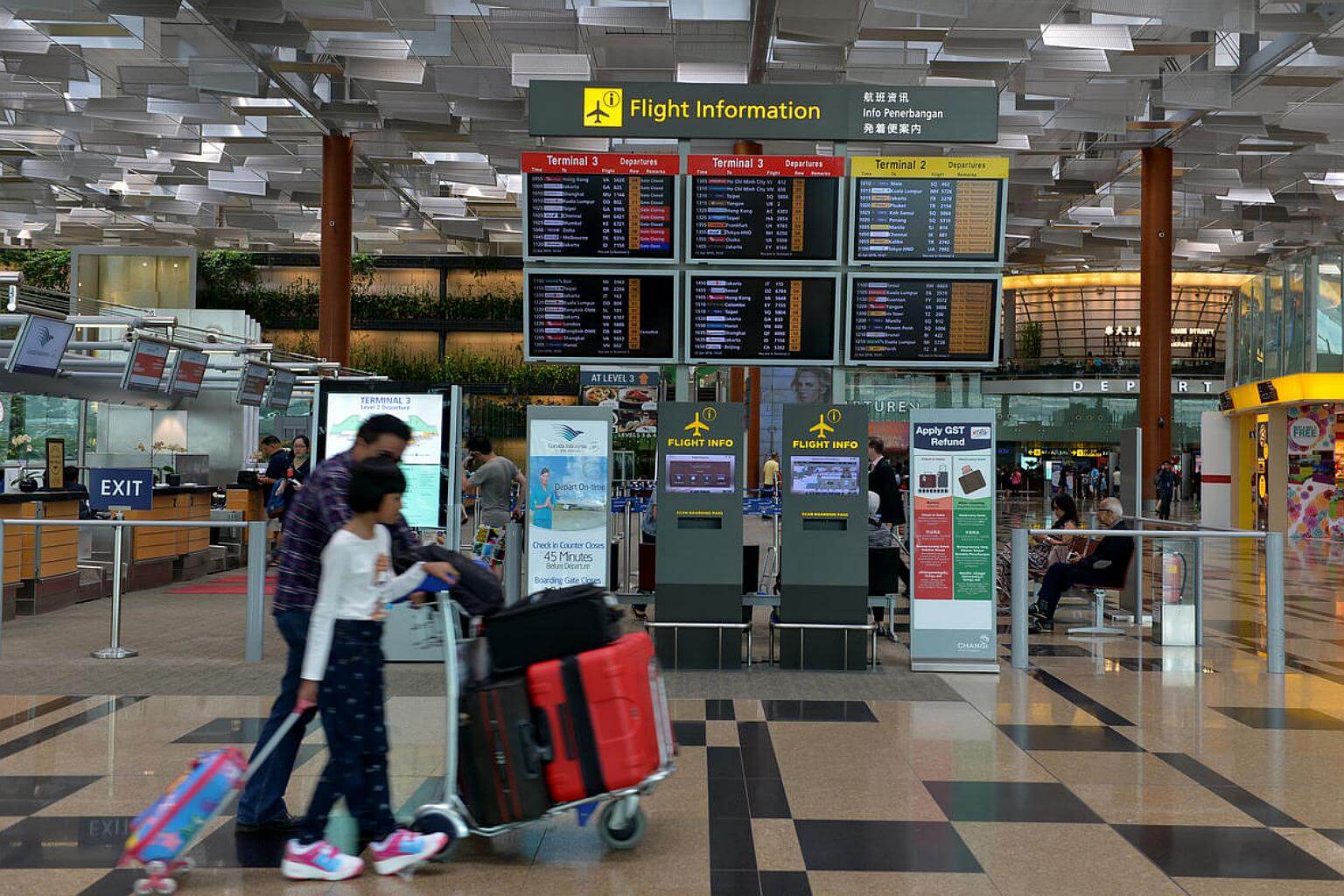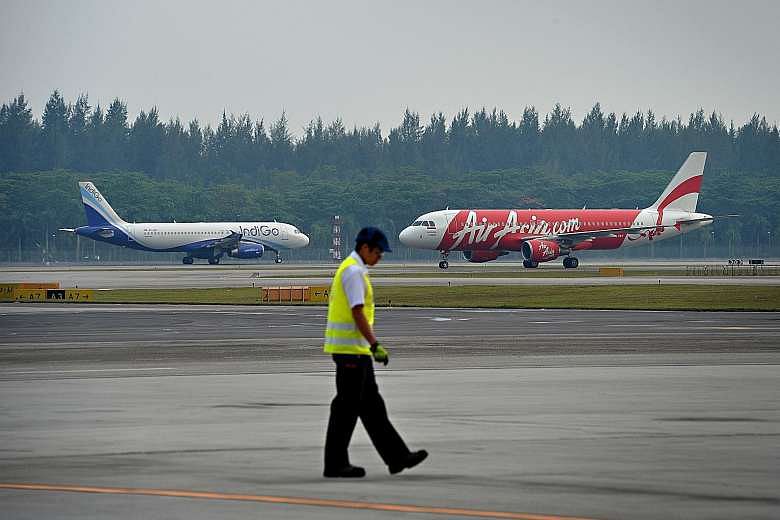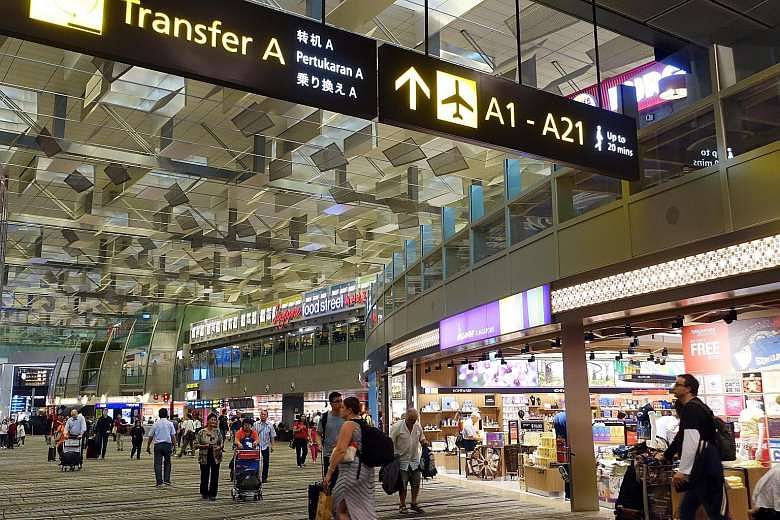Changi's busiest routes set to grow further
But analyst expects biggest growth to come from beyond Jakarta, Bangkok, KL and HK
Sign up now: Get ST's newsletters delivered to your inbox

Travellers walking past the flight information display at Changi Airport Terminal 3.
PHOTO: ST FILE
Karamjit Kaur
Follow topic:
More than one in four travellers at Changi Airport are either going to or coming from Jakarta, Bangkok, Kuala Lumpur or Hong Kong.
The four cities have not only topped Changi's list for the last decade at least, but also featured among the 10 busiest international air routes worldwide last year.
All 10 are flights within the Asia-Pacific, according to the list compiled by the International Air Transport Association.
Work and leisure are the main reasons why regional visitors come to Singapore, among other purposes.
A Straits Times check with travellers and industry experts found that there are many Indonesians, for example, whose children study here.
Many wealthy Indonesians also come for medical and banking purposes. The Straits Times understands some banks provide services within the restricted areas at Changi Airport so their premium customers do not even need to step outside.

For travel between Kuala Lumpur and Singapore, about a third of passengers do so for business, while others come mainly for leisure.
Those who fly to and from Bangkok and Singapore are mainly holiday makers. Budget carrier AirAsia said Thai residents form about 40 per cent of passengers on the Bangkok-Singapore route and Singaporeans, about 20 per cent.
Chinese passengers make up just over 10 per cent of the total traffic, with the rest from other markets.
The proliferation of Asian budget airlines such as AirAsia, Jetstar and Tigerair has fuelled much of the growth in regional travel in the last few years, experts said.
The demand for flights is so strong that even those who fly full-service carriers such as Singapore Airlines sometimes end up on the waitlist.
Ms Allison Lim, 45, managing director for South-east Asia at a public relations firm, travels once or twice a month to Jakarta for work.
She said: "If I book a week or two in advance, there are no issues but if I... book a day or two before, I often end up on the waitlist."
Changi Airport Group spokesman Ivan Tan said the positive growth trend for the four markets is expected to continue in the medium to long term as Asia develops.
As South-east Asian countries continue to liberalise air links, more regional carriers are also looking for opportunities in Kuala Lumpur, Bangkok and Jakarta, he added. This could translate into more flight options for passengers, as well as opportunities for travellers to explore multi-destination itineraries within the region.
Changi also continues to work with the Singapore Tourism Board and other partners to grow different traffic segments, such as for the Mice (meetings, incentives, conferences and events) industry and the fly-cruise segment, he said.
While Bangkok, Jakarta, Kuala Lumpur and Hong Kong are the four largest markets for Changi and will likely remain so in the future, Centre for Aviation analyst Brendan Sobie expects the biggest growth to come from other routes.
He said: "These four markets are relatively mature and are now suffering from overcapacity. It wouldn't surprise me if we saw some capacity reductions and consolidation in these markets."
Secondary destinations in South-east Asia, and especially in China, are likely to drive most of the future growth at Changi, he said.
He added: "Changi should be increasing its focus on improving its connectivity within Asean and China rather than long-haul services as the regional connections are an important USP (unique selling proposition) that differentiate Changi from competing hubs in other regions."
Hong Kong-Singapore

For the past 10 years, Mr Davis Cheung has been travelling from Hong Kong to Singapore for business up to four times a year.
And once every two years, Mr Cheung, 45, a finance director of a multinational firm, takes his family to Singapore for a holiday.
He is one of 2.8 million passengers who travelled between Hong Kong and Singapore from January to October this year.
Kuala Lumpur-Singapore

A third of Malaysians heading into Singapore are business travellers such as IT consultant William Ng, 30, who visits about once a month. Most of the time, he is in and out the same day or overnight. Even so, he expects these trips to become scarcer.
"It is a very competitive market in Singapore. It is not something we can count on. Once these projects come to an end, business in Singapore will dwindle," he said.
Mr Ng is not alone as the proportion of those flying to Singapore from Kuala Lumpur for work has been shrinking.
Bangkok-Singapore

Johor native Jolin Day is carrying a backpack that dwarfs her small frame, and a plastic bag bulging with packets of Thai barbecued pork.
The 30-year-old is heading back to work in Singapore, where she runs a mobile phone accessories shop, after taking a short break in Bangkok. Two of her friends from Johor took a bus into Singapore to join her on her AirAsia flight out of Changi Airport, she told The Straits Times just before she boarded the plane back to Singapore.
"We will go with whatever flight is the cheapest," she said.
Jakarta-Singapore

Singapore remains the top destination for travellers from Indonesia, with more than three million flying from Jakarta to the Republic in the first nine months of this year, according to Changi Airport. Hundreds of thousands more fly from other Indonesian cities.
Most travel for holidays, work or school, or for day trips to attend to personal needs such as banking and medical appointments.
Whenever cruise consultant Amanda Soebandi, 25, visits Singapore, she will be on the lookout for the next cool cafe to hang out with her Indonesian friends. She will also eat chicken rice and head to Tiong Bahru Bakery to have her favourite coffee and bread.

